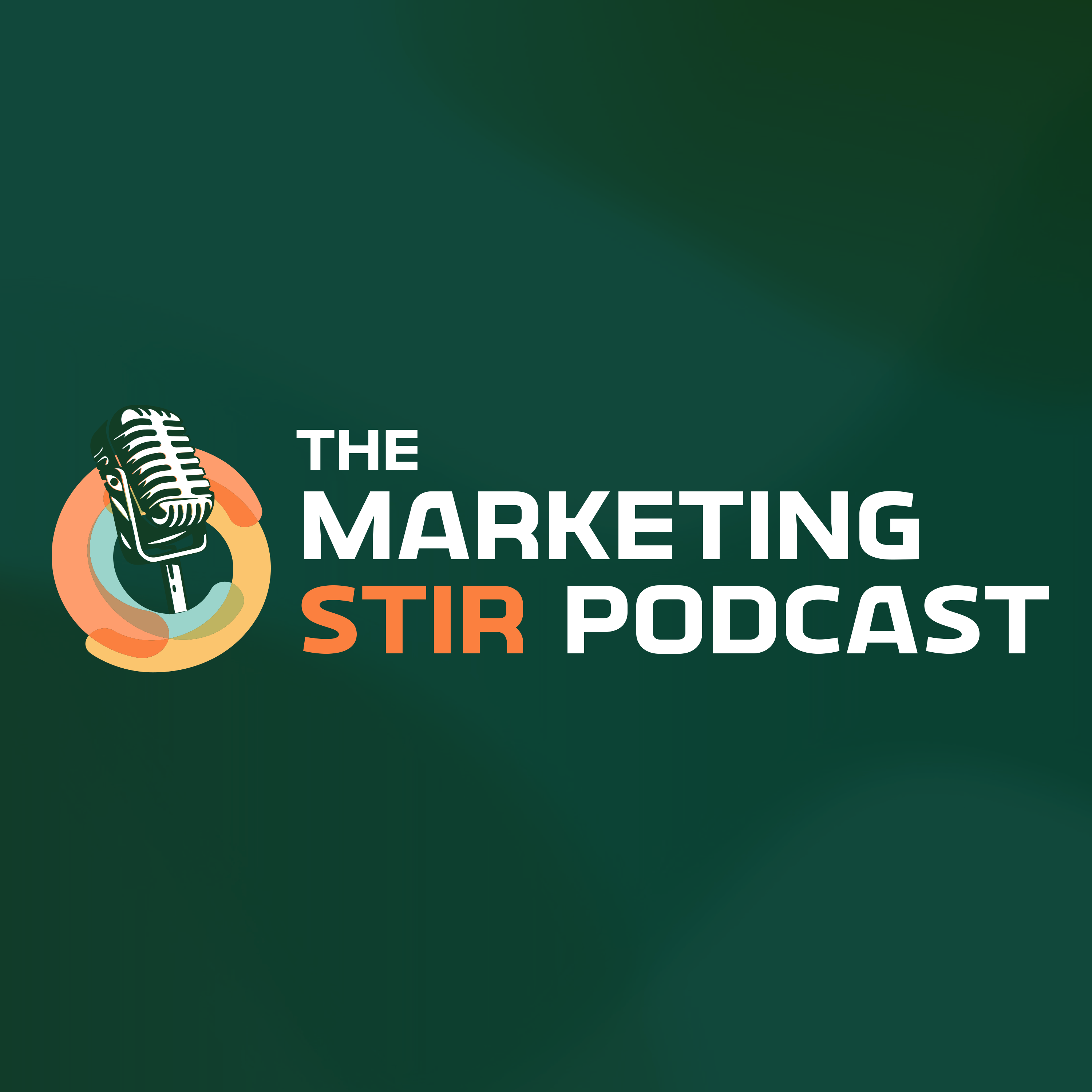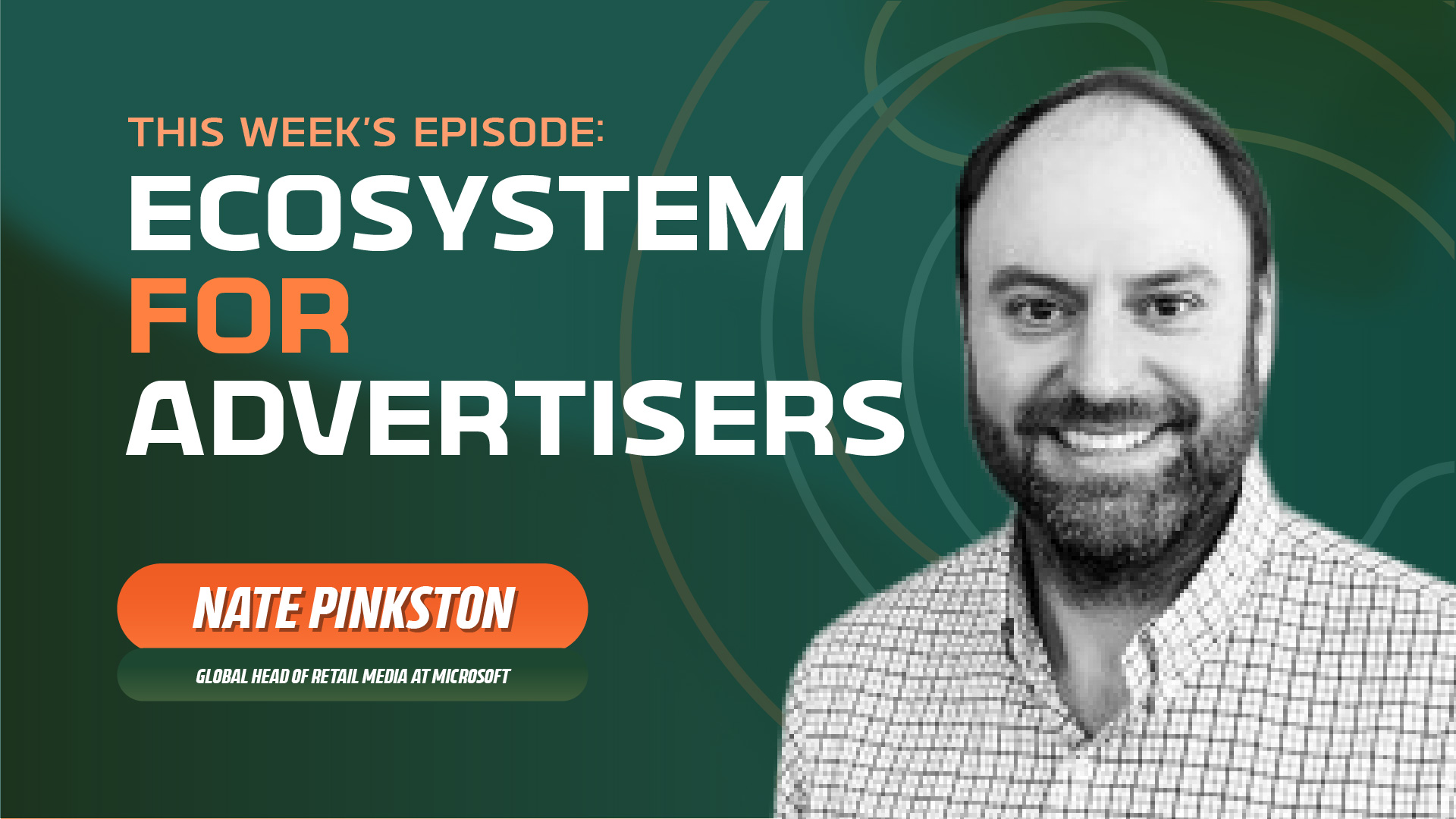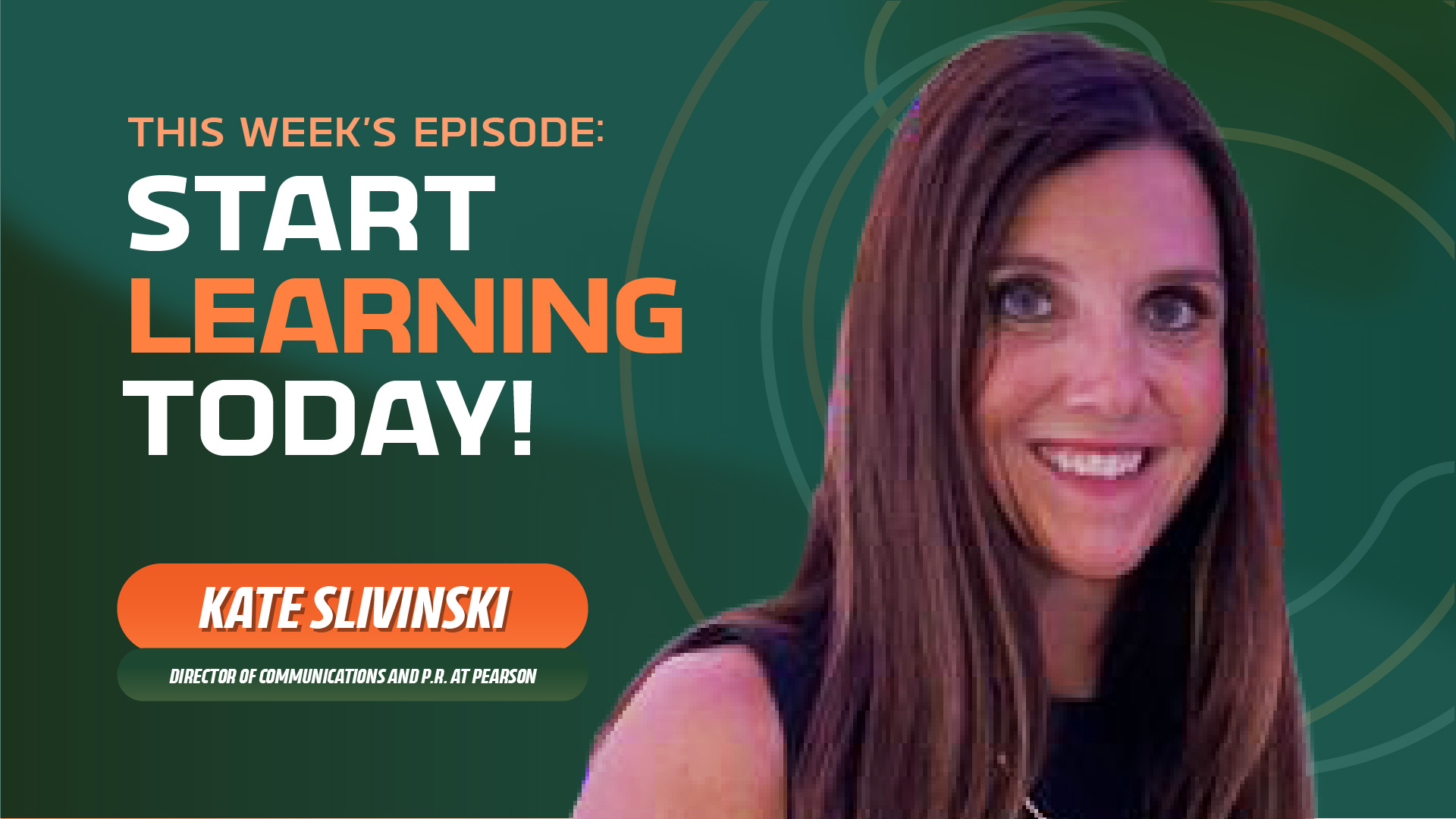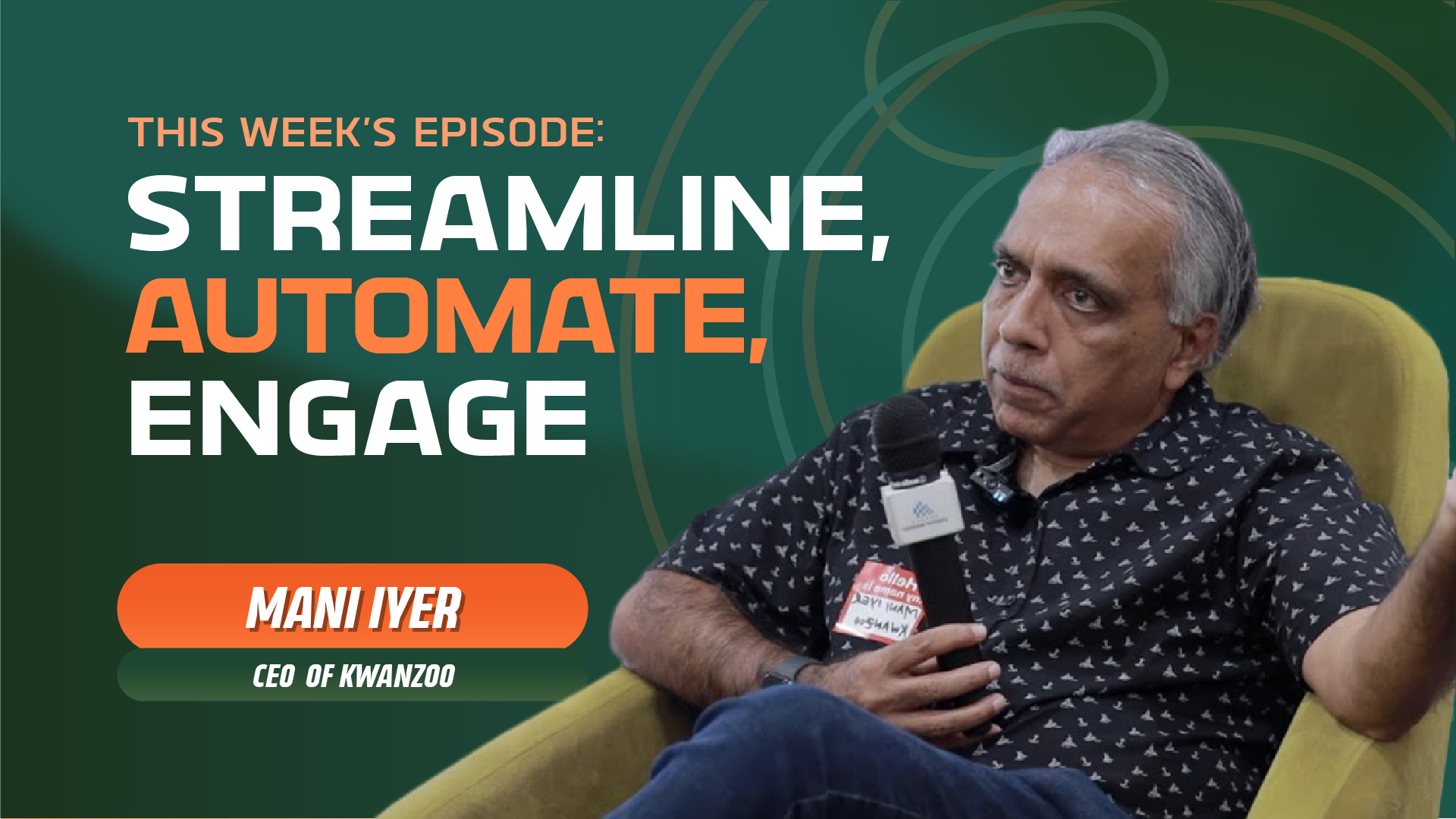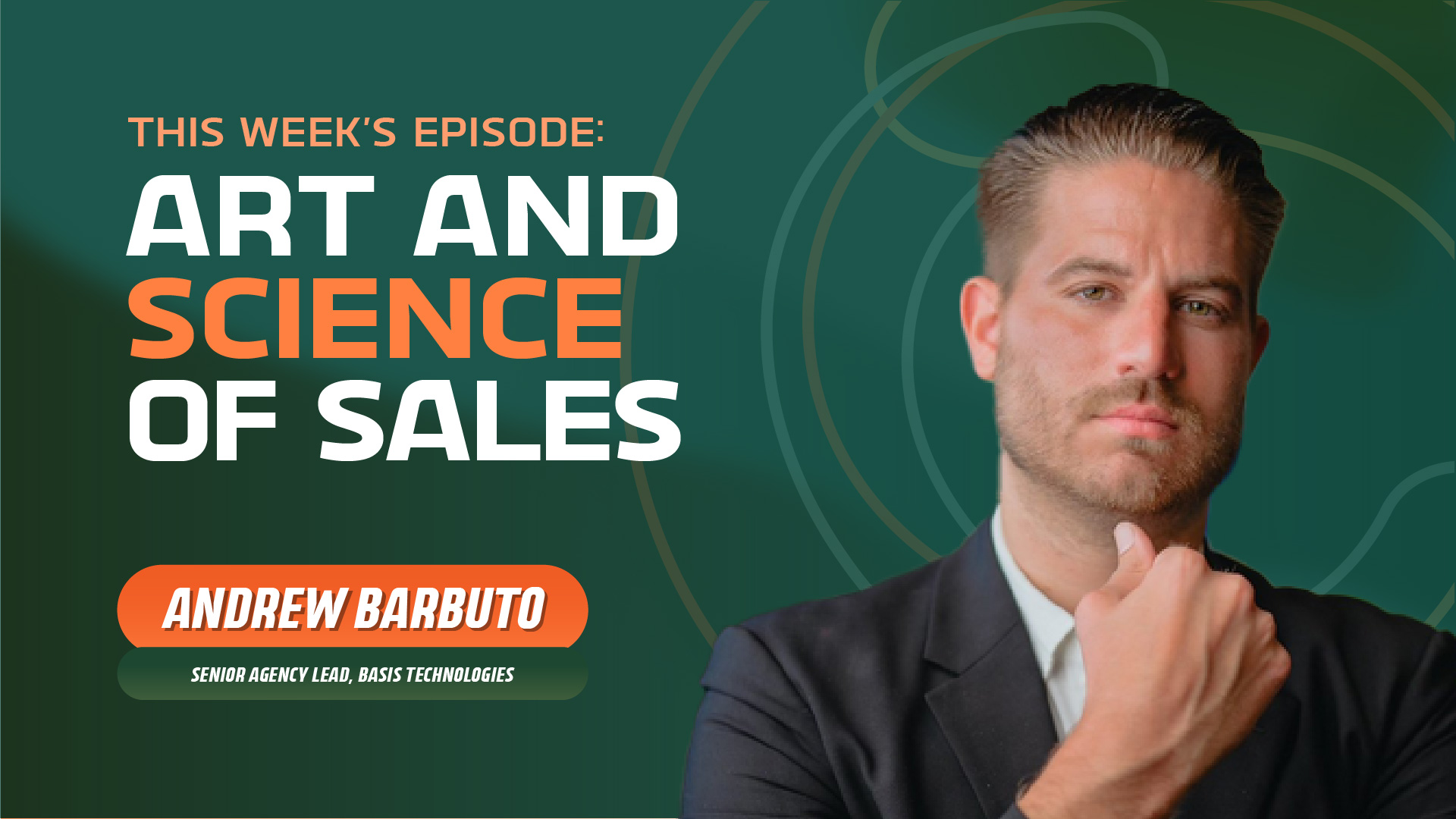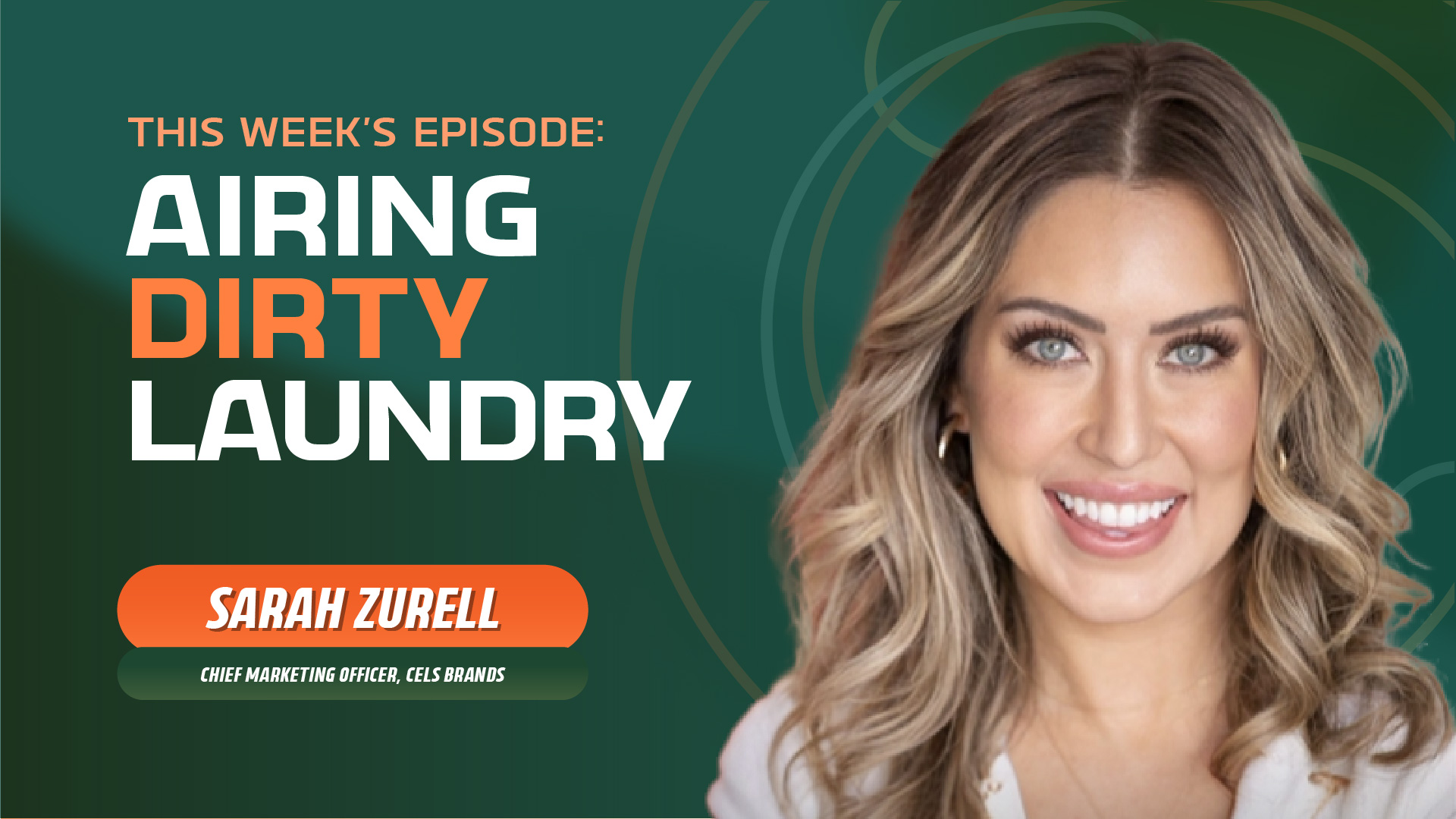Drew Moffitt (KumoSpace) - Togetherness with your Colleagues
- 0.5
- 1
- 1.25
- 1.5
- 1.75
- 2
Announcer: Maybe big data has gotten too big. Whether you're a B2B marketer or a consumer brand, your data needs to be viable, relevant, and accessible, so that Stirista can help you retain customers, acquire customers, and make it personal.
Ben: Welcome to The Marketing Stir Podcast by Stirista, probably the most entertaining marketing podcast you're going to put in your ear. I'm Ben, the producer here at Stirista. The goal of this podcast is to chat with industry leaders and get their takes on the current challenges of the market, and we'll have a little funnel along the way. In today's episode, Ajay and Vincent chat with Drew Moffitt, Head of Marketing at Kumospace. He talks about the importance of human connection, regardless of if a company is operating in office, fully remote, or with a hybrid approach. Ajay enjoys a weekend at the Horseshoe Bay Resort and Vincent to look forward to the upcoming holiday summit on December 8th. Give it a listen.
Vincent Pietrafesa: Ladies and gentlemen, welcome to another episode of Stirista's, The Marketing Stir. It is so nice to talk to you. I am your host, Vincent Pietrafesa, the Vice President of B2B Products and Partnerships here at Stirista. Who is Stirista? Let me just pause one second. Maybe, well 12 seconds to talk about Stirista. We're a marketing technology company. We own our own business to business data, business to consumer data. We help companies utilize that data through our own technology to help them get new customers top of funnel. We have our own email sending structure, our own DSP where we do display, OTT connect to TV. Email me vincent @ Stirista.com. That is how confident I am. I just gave you my email address. And boy, are you using it. Not always for what I intended it to be, but hey, I put it out there so it happens. Anyway, it is so good to be here with our listeners and thank you so much people for coming up to me and my co- host, Mr. Ajay Gupta, we'll get to him in one moment, at conferences now. We love that you're listening to our podcast and we love that you're coming up to us and telling us you listen to it and giving us ideas. We really do appreciate it and I appreciate this next person, my co- host, ladies and gentlemen, he was here in New York, but now he's back to San Antonio. All of New York misses him. Ladies and gentlemen, Mr. Ajay Gupta. What's going on, Ajay?
Ajay Gupta: Hey, Vincent. Good to see you again. Just had a good relaxing weekend at Horseshoe Bay Resort. It's about an hour from San Antonio.
Vincent Pietrafesa: Horseshoe Bay Resort. Shout out to Horseshoe Bay Resort. What's going on there? You just had a retreat with the kids or just without kids?
Ajay Gupta: This one of the few times without kids. It was a clay court tournament with our very own, Hunter Snell.
Vincent Pietrafesa: Oh, nice, nice. I almost was 100% certain it was without kids, because the smile on your face is the smile that I often have when I was just in London without the kids and I was able to sleep for 10 hours. Boy, was that amazing. No, kids are great. You know how I love kids, ladies and gentlemen. I have two of my own. We love it. Love it. But that's awesome. And I'll be down. I'm coming to San Antonio, ladies and gentlemen, on December, we have our summit December 8th, that's going to be virtual, third annual. Always have a lot of amazing surprise guests on there. In the past, we've had Mick Foley, the wrestler. We've had San Antonio Spurs on. We have had, of course, amazing guests. Some of the podcast guests make a return to that one. So give that a listen. I know Ajay's going to roll out the holiday red carpet for me. If not, you'll hear about it, ladies and gentlemen on the podcast, if he does not.
Ajay Gupta: Yeah, that's right. I think it's one of the nice things that came out of the pandemic other than this podcast, is we started doing our virtual holiday party, which is inclusive of all of our various countries and states where we have folks in that don't always get to feel like they're part of the San Antonio team. So I think there will be no exception. Started in the pandemic, but we will continue to do the virtual portion of the holiday party.
Vincent Pietrafesa: Absolutely. That is hosted by yours truly, ladies and gentlemen, and we have a fun time. We often bring in some of my friends, who are comedians and they just kind of lighten the mood. We do some charitable work as well on there, and it's just a great time. So hopefully this episode airs before that. If not, hopefully you were there. If you missed it, there's always next year. But Ajay, we have a great guest. This guest is one of the rarities where we've actually both met him in person. I think that was maybe out of 125 guests, maybe we met four of them both in person, maybe five. This is one of those rarities. And I'll tell you, I knew it right away about him and not just because of the beautiful painting of the New York City skyline in the background, which you'll see in a moment. But I was like, " Wait a minute, you're a New Yorker, like me?" Again, I say it on the podcast, you could always tell when people are from New York. And we really liked them and we went to a Rangers game together, the New York Rangers, they won a game. So he's good luck. He's also good luck this guy. So we are so happy to have him today. We're excited to hear of his company, Kumospace, ladies and gentlemen. Kumospace, if you haven't heard of it, you're going to hear about it now. We really love what they're doing. Ladies and gentlemen, he runs marketing there, Drew Moffitt. What's going on, Drew?
Drew Moffitt: Great to be on your show. I'm excited to talk about Kumospace, what we're building over there, and also just my experience as a marketer and a little bit about my career.
Vincent Pietrafesa: Absolutely. I was fascinated with your career. You're a young guy, certainly younger than me, and I love where you've kind of gone with your career. You go all in, man. That's the thing about you that I really like and glad that we know each other now Drew. But let's get it right out there. Talk to us about Kumospace and then your role within the organization.
Drew Moffitt: Yeah. Kumospace is building virtual office software for distributed teams to show up and work together. I have the privilege of being one of the earliest employees at the company. I've been doing marketing the entire time that I've been here, and I've really gotten to see the company grow from a couple users to millions of people, and now two venture funding rounds later. Collectively, the company has raised over$ 24 million.
Vincent Pietrafesa: That's awesome. That's awesome. Talk to me about your role within the organization, Drew, what you're tasked with doing, and then also how you got into marketing. That's one of our staple questions people love hearing about it.
Drew Moffitt: So there's a really good memo by the CEO of Slack in 2013 called, We Don't Sell Saddles. And a little bit of my role feels awfully a lot like that. We're building virtual office software. The benefit of our product is it's a new type of communication tool for companies to work, distributed, hybrid or remote. And it's going back to synchronous communication. The kind of communication we're having right now, this tends to be very efficient. It's how humans have communicated for thousands of years. And asynchronous communication is things like Slack, carrier pigeon, writing a physical letter. Those were the things that historically, people always defaulted to as their secondary form of communication. But in this post pandemic and during the pandemic, as companies got really remote for a period of time, they were relying heavily on sending asynchronous communication, a lot of email, a lot of Slack, lot of Teams type messaging. So our product brings people together. Typical users find that they have fewer meetings, they're more productive. I've got some good examples. For example, recently I was building on a new section of the website and I had to go quickly ask some questions of our designer and in a typical, he's in Idaho, I'm in New York, typically that would mean go grab a time on his calendar, set up a Zoom call or some other type of call and then ask him these questions. Instead, I just toggled over to where he was in our virtual HQ and started working through some stuff. Well, what about this edge case? When the user shows up and we don't know what device they're on, what's the content we want to display on? So that's Kumospace, based on a nutshell. And then my task there is trying to figure out how you make the world aware of that. A lot of people today are just not looking for that. They're often looking for the vitamin, you guys were talking about hosting your virtual holiday party. That's a way that a lot of people find us is they come to us saying, our team is distributed across several countries or across the United States or Europe or honestly all around the world, and we want to connect those people in a way. And then they learn about the virtual office use case for Kumospace. So my job is to let them know that they can use it for virtual holiday parties as well as an ongoing daily active use case for our virtual office.
Vincent Pietrafesa: Nice. And how'd you get into marketing, Drew?
Drew Moffitt: It's a great question. I was a little bit naive. I went into college in 2007. The economy was great then, and I kind of just thought, "Oh, I'll go work on Wall Street. I'll make a bunch of money, it'll be easy." And 2011 rolls around. My understanding of the kids these days, they tend to be a lot more aggressive about getting into internships in maybe their sophomore or junior year. It wasn't something I was doing, maybe I just wasn't given that insight. And I went to a small liberal arts college, so they didn't have the big banks like Goldman Sachs coming and knocking on the door doing on- campus recruiting. And I ended up graduating, kind of figuring out what to do. It was a tough job market, and I ended up working for a woman selling residential real estate. And she was a very tough cookie to work for, but it taught me a lot. Often, she's kind of compared to the Meryl Streep's character from Devil Wears Prada of real estate. So we were selling in this average of $30 million price point. So really taught how to interact with that kind of people. And this is 10 years ago, so real estate prices were cheaper back then. But I yearned for something more. So I finagled my way into some classes at Columbia Business School here in New York, launched a startup, and then very quickly it became clear that it's not just about launching an app in the app store, you need to market it. And that's how my journey as a marketer started 10 years ago.
Ajay Gupta: And Drew, coming to Kumospace, what makes it the ideal choice for companies that are looking to go remote and how does it differ from other platforms?
Drew Moffitt: I think the statement I was making before about asynchronous versus synchronous communication is really why I think people tend to start using Kumospace and really like Kumospace. So a lot of users will speak about having far fewer formal meetings and said they have a lot of burst communication because we're trying to replicate those interactions of a physical office. Think about if you just had a question for Vincent and if you guys were both physically together in the same space, you wouldn't necessarily default to sending him a message on Teams or Slack. You would walk over and tap him on the shoulder, and that would lead to more questions or quick comments. So a lot of users tend to have these five to 10 minute conversations that quickly unblock them during the course of their day. And that's really the productivity piece of it. But the secondary piece is that you tend to start building more sense of togetherness with your colleagues. So you start to learn about them because you're again, defaulting to talking to them versus Slack messaging or teams messaging them. And it tends to result in more bonding between different members of the team that are often on different departments. And you also don't have these moments of miscommunication. People sometimes talk about these Slack wars where they're like marketing's arguing with engineering about getting something on the page and engineering doesn't understand it and marketing is frustrated about it. But when you're doing that in a synchronous way, you understand their body language. And what often ends up being the case is that engineering isn't not wanting to do the task, engineering is just confused about the ask.
Ajay Gupta: That makes sense. What do you think is going to happen as people are going, more offices are going back to work? Do you think since you start, kind of a pandemic baby, is it going to thrive in the post pandemic world as well?
Drew Moffitt: Yeah, I think the right thing that people are doing is you need to pick the right organizational strategy. And there's about six organizational strategies out there. You've got in office, you've got 100% remote, and then you've got four versions of a hybrid structure. And typically it's among smaller companies, it's four or five times the amount of companies have gone more remote. So that benefits us as the market having changed over the last two years. I think the thing that's kind of out to be decided is how those larger companies, are they going to be more fixed, in person hybrid schedules or are they going to become more of a remote first schedule where you come to the office a couple times a month or maybe you go to big quarterly meetings or all hands meetings, but you're predominantly more remote? Since we're not trying to build something specifically for the pandemic, we built a product that was supposed to make human connections better from a video chat perspective. And it did really well in the pandemic and a lot of users started saying, "Hey, we want to use this as our always on virtual HQ for our team." So since it's a communication tool at its core, we don't think that as the world becomes pretty normalized and everyone's going back to hanging out in person and going to sporting events, it's going to necessarily affect it. There's going to be a group of users who prefer to be in office and that's right for those organizations. And there's also going to be a group of users who prefer to maybe be remote.
Vincent Pietrafesa: And I love that term, Ajay, the pandemic maybe was born. The company's 2020, right? And that is hard to launch a company, but based on Kumospace and what you're doing and what you're offering, it makes complete sense for now and in the future. But Drew, talk to us about it's hard to launch a company. And besides being on our wonderful podcast, of course. What's Kumospace doing for brand awareness to get the name out there? Talk to us a little bit about that.
Drew Moffitt: So we had a big tailwind of the pandemic behind us. There was monstrous amounts of Zoom fatigue. And I think really at the core of Zoom fatigue, when you think about, it's just inefficient meetings. And the product that Kumospace is building here, it's about having those more efficient meetings. So we were able to put the product out there on social media, hundreds of millions of views of people using and playing with Kumospace. And in 2021, a lot of use case was people doing everything from little family get togethers to all hands or happy hours or holiday parties all the way up to conferences. So as a result of people using the product so heavily for that virtual event, kind of one off use case, there's a lot of brand awareness behind Kumospace. There's just a lot of organic traffic that continues to come to the site. But it is a challenge to market something in a potentially new space. So if you go back to that memo I mentioned earlier in 2013, this CEO of Slack was saying, no one's going to Google looking for group productivity chat. And that's pretty true today. No one is going to Google. There's a few people looking for virtual office software or virtual office platform. Most people are going to Google saying, " How do I run a better, a more functioning remote meeting?" So a lot of our focus now is about building out content, both really on the own side. So we're going to be doing more social content, but a lot of written blog content to be the resource. Here's some tips to running an effective meeting. Here's ways to have a really fun engaging holiday party. It's really showing the people the vitamin and saying, " Hey, there's also a painkiller in our virtual office product here." Because the product as people are operating any fully customizable virtual environment. So you can make that look like the best holiday party and you can also make that space look like a typical office and have company branding in it.
Vincent Pietrafesa: That's awesome. No, definitely makes sense. And it's something that people who are remote employees as you talk about potential cost cutting measures, right? Let's get everyone together virtually in a different way. I think that that makes a lot of sense. Drew, what's been your biggest challenge right now in your role at Kumospace? And talk to us how you're tackling it.
Drew Moffitt: I think it's trying to figure out what is the biggest things, because as I was saying with that previous example is no one's looking for group productivity chat in 2013 for Slack. It's trying to figure out what are those big drivers, what is our ideal customer persona is definitely one of the challenges for us. Because so many companies are deciding to... The way that a company decides their organizational structure is very much dictated by their employees and their organization. So no customer is truly similar to another customer. We have customers that are teams of 20, 30 people at really large Fortune 500 companies and we also have 30 person startup that's doing cosmetics. And we also have a bunch of health tech startups and healthcare companies. So there's no real ideal consumer right there. And that's, I would say, is probably the biggest challenge is having to market to a wider audience than say I'm just making a direct to consumer product for say, shoes. And it's trendy shoes so that your consumers are probably from 18 to 34 years old.
Ajay Gupta: So how do you approach marketing? What are some of the channels that you're focused on right now and has there been kind of a aha moment in marketing that's been a game changer for you?
Drew Moffitt: Since my career has been pretty diverse, I've started two companies. I've collectively helped build in their five companies, Kumospace being the fifth. One thing that I really learned earlier on in my career, I was doing something called corporate venture building. So the challenge there was I would lead a small team, typically three to four people, including myself and a CEO of a large public company would say, " Hey, build me a new business in XYZ industry." And the challenge there was I didn't get to pick the idea and I didn't get to pick the industry, but I had to kind of deliver some fledgling startup or business. So when I approach marketing at any role now it's put out a lot of ideas and then figure out how to quickly test on those ideas. So for us in 2021, we did really effectively control the cost around influencer marketing. And that's what resulted in these hundreds of millions of views on social. We first off, set aside some money, we tested it and I'd had some earlier success in other projects with it. And then we went about figuring out how do we really control cost. Because wanted to have low upfront fixed cost with high variable cost to reward a lot of content if that content got a lot of views. But prior to that, we had a really good idea, which completely fell on its face, which was let's just email a bunch of venture capital funds and say, " Hey, why don't you use this for your portfolio?" They're all remote right now. They're all pretty early stage startups. This was in late 2020, early 2021. No VC wanted to help us. And it makes sense in hindsight is it sounded like a good idea, but those VCs were busy trying to look for deal flow or do something else. They weren't particularly interested in trying to distribute our product on our behalf to their network. So I think it really just comes down to saying, " Hey, where do I think I could possibly find this person and let me go test it." And SEO is something that we've invested in recently and we're starting to grow traffic and we're putting eyeballs in front of these keywords that are related to things like have a great holiday party, run a better meeting, how to manage a remote team, things of that nature. So basically, be really eager to test ideas but also be really eager to say, " I screwed up. That was a great idea, but not the right business, not the right market, something didn't align correctly," and move on to the next thing so you can use that time for something that might work.
Ajay Gupta: Any cool new products or anything interesting coming up in the future that you can share with us?
Drew Moffitt: Yeah. So we just launched a desktop application Kumospace primarily runs in the web browser. So we just launched a desktop application to help. As a communication tool, it's good to have it on your desktop, on your control panel and running in the background. We're launching mobile apps. If we're trying to help teams distribute it, their wifi might not be particularly good in any moment. That team member may be on the move. So we're launching mobile apps really soon. Another thing is, just in a physical office where the default is to walk over and maybe have a conversation with your colleague and have that synchronous communication, but if your colleague isn't at their desk, you're going to do something in an asynchronous nature. You're going to leave them a post- it note, you're going to send them a message. So in the really near term, we're launching a lot of improvements to our asynchronous communication within Kumospace, specifically around the chat function apps.
Vincent Pietrafesa: Drew, I mentioned in the beginning, you and I met in person, we talked and something I was fascinated with is like you said, at a young age, you were just like, I'm just going to dive into companies, I'm going to join startups, I'm going to invest in some companies, I'm going to start companies. That's awesome. So I would love for you to share some of those experiences at some of these startups. Any projects that really resonated with you, obviously besides Kumospace? You mentioned a bunch of them. What do you think really stood out to you during some of those experiences, besides working for the real estate Meryl Streep character?
Drew Moffitt: Yeah. I think stupidity was probably the best. I was very stupid and naive and thought that you just create a company and then it's Facebook. Maybe I watched The Social Network one too many times. But being pushed and forcing myself into that situation caused me to learn. And I would say forever not was probably, it was the first time I did and it really had an impact on the direction of my career because I left the job in real estate. I was auditing these classes at Columbia Business School. I had gotten some engineering students in the engineering school to help work on this. We're building a mobile app that was going to let people relationship bet on the relationship status as of celebrities. And the product, got it to market, figured out how to build an app, get it through the app store, and then I need to market it. And I thought, all right, well some good marketing for this is it's related relationships, Valentine's Day is coming up, let's pair the launch with that. And I lucked out. I was able to get a lot of PR around it. I had seen the Warby Parker and Harry's, those were the co- founders of those two companies, I'd seen one of their pitch decks for media, so their media kit. And I was able to basically just replicate that from memory in this presentation in one of the lecture halls. And I made our own version of it and it quickly went viral. And then Apple decided, whoa, this is not conforming with our aerial brand, relationship betting on celebrities, this feels maybe a little too mean, and they removed us from the App Store. But the story of that was that it was night and day. I was sleeping on a couch and the next day I was on Good Morning America. And day after that I didn't have a job. It was all in about a month period of time. So it was pretty crazy emotional rollercoaster. But the thing that I really took away from that, that was a fun experience. And there was also a lot of intangible things that don't easily translate maybe to a resume that I had learned from that. And that's what set me on this journey to ultimately now being at Kumospace.
Vincent Pietrafesa: That is awesome. And then I also, I want to share, you said in the beginning about a lot of people they leave college and they're like, " I'm going to get a job making a lot of money." And you mentioned looking back in internship, and I do see that too, a lot of our interns here are still college students. But what advice... you've already, you lived a lot, like you said, one day you're on Good Morning America and then you're looking for a job a couple days after that. But talk to us, Drew. What advice would you give college students now looking to maybe start a company or pursue a career in marketing?
Drew Moffitt: I think if you're looking to pursue a career in marketing, the first thing I would say is that always try to remove yourself from the product you're marketing. And what I mean by that is it's really easy to know what you're just doing to market this product. But you need to put yourself in the shoes of that prospect you're marketing to. So good example is you'll go to a website, maybe an very early stage startup, and you'll look at the hero copy and you'll just say, "What the hell are they trying to sell me?" And to them it makes a ton of sense because it's their product and they understand that product. But me, as the visitor, has none of that context around it. So as a result, I'm confused, which is not good. So always try to think about, well, what are the relatable things that I can try and convey to this customer so that they understand what we're selling? And then the secondary piece of it is I've learned, and it's worked out for me, I've learned just a lot of skills and I'm always learning new skills and tactics. So I think there's two ways you can approach it. One, you can just become an expert in something very specific. For example, maybe paid marketing or social media. But I would say try to really expand your depth of knowledge. Try to learn how to do social, try to learn how to do paid, try to learn how to do SEO. Try to learn a lot of different things. It may be harder to translate on a resume, especially if someone's trying to just hire a PPC expert. But you'll get roles where you're more of a generalist and those generalist skills I think will benefit you in the long term. And if you want to have more seniority, you need to be able to speak to more skill sets than just one.
Ajay Gupta: Thanks for the advice. One of our staple Marketing Stir questions is to do with LinkedIn. I'm sure you get a lot of messages and connections from people you have no idea who they are. What are some messages that get a response from you and more importantly, what are ones that really annoy you?
Drew Moffitt: Yeah. So I'll start off with the bad ones. It's a little unfair, my answer, because of one thing, I run a meetup that looks like a business. So when people try to personalize and target me, they're often targeting me like, " Hey, get better corporate data for your SDRs to do your venture sales." I'm like, venture sales is a meetup, it is not a business. So I'm in that kind of fringe bucket and I get it, there's an 80/ 20 rule. If you're scraping information and you're compiling and personalizing, but I'm just in that outside bucket so I get a lot of noise that's just completely unrelated because people think that my networking event is actually a business. The stuff that works, couple of things. One, I've always appreciated when people, whether or not we end up hiring the candidate, but I've always appreciated when people reach out to you on LinkedIn when they're applying for a role. It just shows like a degree of dedication and interest in the company to reach out or send a message related to something. The other one, this was actually an email. It was a cold email. Again, don't respond to a lot of them, but it worked out pretty well. There's a tool called Chili Piper. It just so happened that their SDR lucked out in that very moment. I was trying to figure out how to improve conversion on our schedule demo page. And the person had sent me a screenshot showing our booking widget and it said, " Improve your conversion." And it was just, in that moment, it was super relevant to me. So we ended up actually using the tool and we still use it today on our website.
Ajay Gupta: Great. That's a very unique answer. So that's the first one. Tell us a little bit about your personal side, because this is a little bit like if we had met you and actually we did meet you in this case and we were chatting. What do you like to do for fun? What are some of the hobbies outside of marketing?
Drew Moffitt: So I started skiing at a really young age. So now that it's getting into the winter months, I'm very excited to go skiing. Got some ski trips planned. I also do some sailing. That's a big piece of my summer months. But other than that, I'm pretty big extrovert. As I mentioned, I host a meetup, so I tend to meet a lot of people, network with a lot of people, like to just be around people.
Vincent Pietrafesa: And that's in New York City, right Drew? Is there a way people could get invited to that or reach out? How could people find you?
Drew Moffitt: So for venture sales, it's a meetup for founders and VCs and people who are operators in startups or large corporates. It's venturesails. co. Also, the. com works as well. Important thing is that it's spelled like a sailboat, not sales, like selling something. And again, that's venturesails, like a sailboat. And yes, if you go to the website, you fill out the form, I follow up with everyone and you'll get invited to these happy hours. They tend to be kind of small groups, good quality group of people. So if you're in the New York area and you're in the startup or the venture investing space, definitely reach out.
Vincent Pietrafesa: Nice. I will be there at one of them hanging out with Drew and the crew there. And then I will, I'm sure it's going to be a great time and I'll talk about it at the podcast. And so hopefully more people will come out. Drew, a closing thought. Anything you want to part our amazing audience with, about yourself, about Kumospace, about future of marketing? You tell us. The floor is yours my friend.
Drew Moffitt: Yeah. Really appreciate you guys having me on the podcast. It's been a lot of fun. Suggest to anyone who's running a distributed or remote or hybrid team, check out Kumospace, book a demo with our team. Product's free to use. Let them show you around. If you actually want to see me in person and you schedule a demo, there's a high likelihood that you'll actually potentially be in the same place because all of our sales demos happen inside of our virtual office where our 30 plus team members are working, including myself. So I'll be there and you can ask us to come say hi and connect with me. As far as the future, I think the way that you decide to run your organization really just comes down to picking a clear organizational strategy. One thing that employees and team members are going to never enjoy is not being clear. Just say, " Hey, this is how we set goals." I really emphasize teams that prioritize results versus face time and presence and just tell your team how success is going to get managed and how you expect them to work, if that's hybrid or if that's remote or whatever it might be.
Vincent Pietrafesa: I like that. I like that. Thank you, Drew, for joining us on the podcast, giving us some time and parting your knowledge on us. Check out Kumospace, ladies and gentlemen. That's Drew Moffitt, I'm Vincent Pietrafesa, he's Ajay Gupta. This has been an episode of The Marketing Stir. Thank you so much. We'll see you soon. Thank you for listening.
Ben: Thanks for listening to The Marketing Stir podcast by Stirista. Please like, rate and subscribe. If you're interested in being a guest on the podcast, please email us at themarketingstir@ Stirista. com. And thanks for listening.
DESCRIPTION
Ajay and Vincent chat with Drew Moffitt, Marketing at KumoSpace. He talks about the importance of human connection regardless of if a company is operating in office, fully remote, or with a hybrid approach. Ajay enjoys a weekend at the Horseshoe Bay Resort, and Vincent looks forward to the upcoming Holiday Summit on December 8th.
Today's Host
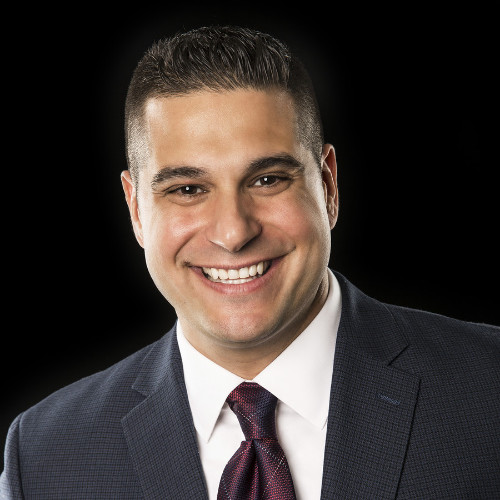
Vincent Pietrafesa

Ajay Gupta
Today's Guests


